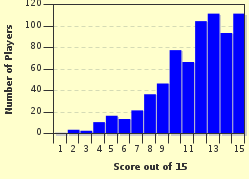Quiz Answer Key and Fun Facts
1. Two forces "move the world", wrote German poet and philosopher Friedrich von Schiller, and the father of psychoanalysis, Sigmund Freud, based his theories of human sexuality on the same two motivations. What are they?
2. "As truly serious art must follow the greater laws, and not only appearance, I try to put all the elements in motion in my mobile sculptures. It is a matter of harmonizing these movements, thus arriving at a new possibility for beauty." Which American sculptor is credited with the invention of the first abstract moving installations called "Mobiles"?
3. This figure skating move - a jump launched from the forward outside edge of one skate and landed on the backward outside edge of the other, with one and a half turns in the air - is called after the first name of Norwegian skater Paulsen, who was the first to perform it in 1882. What jump is it?
4. With his active support of the Copernican doctrine that the earth moved around the sun and not vice versa, this astronomer contradicted the teachings of the church, was accused of heresy, and was forced to recant his belief. According to a popular legend, though, after his confession, he is said to have summoned the mutinous sentence: "And yet, it moves!" Who was he?
5. What is the informal name for the vehicle with bullet-proof glass sides, designed to carry the Pope safely while he moves through the crowds?
6. There is only one move in chess where two pieces - the king and the rook - may be moved at the same time. What is this move called?
7. Thirty-two turning "fouettés" (or whip-like movements) are traditionally performed by the seductress Odile, wearing a black tutu, in the coda of a famous pas de deux. A spectacular bravura display for every prima ballerina, it is one of the high points of a romantic ballet. What ballet is it?
8. What sole item did Greek mathematician Archimedes claim to need in order to raise the world?
9. By what Nordic word do we call a very large or violent whirlpool which is generally the result of conflicting tides?
10. Actors must be trained to achieve complete control of their movements, and every single movement they make on stage must derive from an inner motivation, stated this legendary Russian actor and stage director who originated a system of acting - known simply as "the method" - which revolutionised the world of theatre, and greatly influenced later teachers, such as Lee Strasberg. Who was he?
11. This marine fish with an elongated, spear-like upper jaw is considered by many sources to be the fastest creature of the sea. A particularly big example engages in an epic battle with an old fisherman in one of the most fascinating tales of world literature. What fish am I referring to?
12. The constant random motion exhibited by microscopic particles of matter when suspended in a solution is named after which Scottish botanist?
13. What term (from the Italian for "jest"), denoting a lively and usually playful instrumental composition, often refers to a single movement of a symphony, sonata, or chamber work?
14. The world's largest transmigration project was initiated by the government of this country during the 20th century. It was a controversial program aimed at moving people from overpopulated areas - in particular from the islands of Java and Bali - to less crowded places. What country is it?
15. "One cannot step into the same river twice", stated Greek philosopher Heraclitus, because the universe is in constant motion. What does his famous aphorism "Panta Rhei" translate to in English?
Source: Author
Arlesienne
This quiz was reviewed by FunTrivia editor
Nannanut before going online.
Any errors found in FunTrivia content are routinely corrected through our feedback system.

